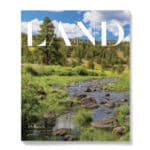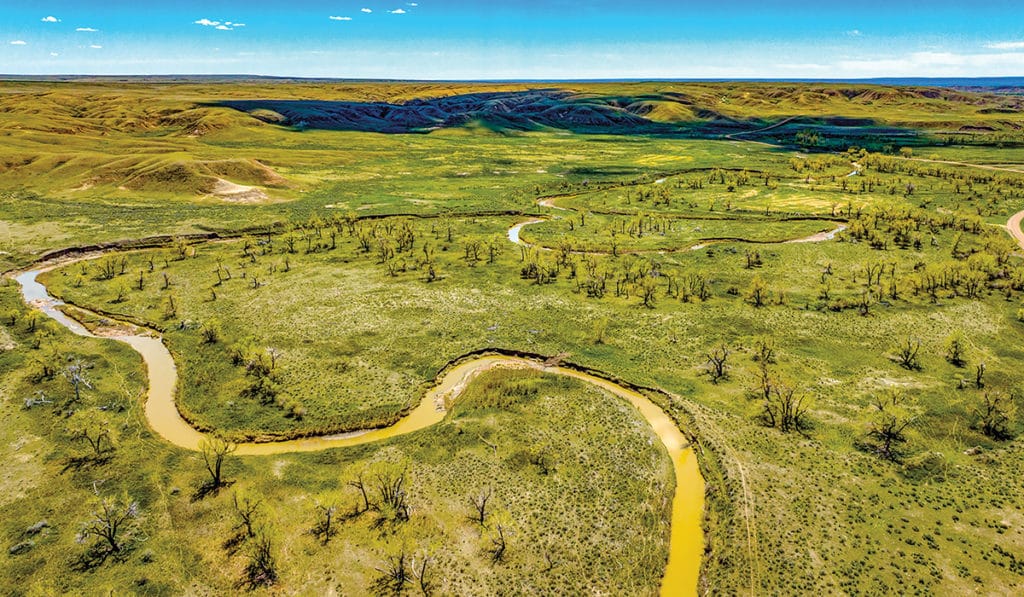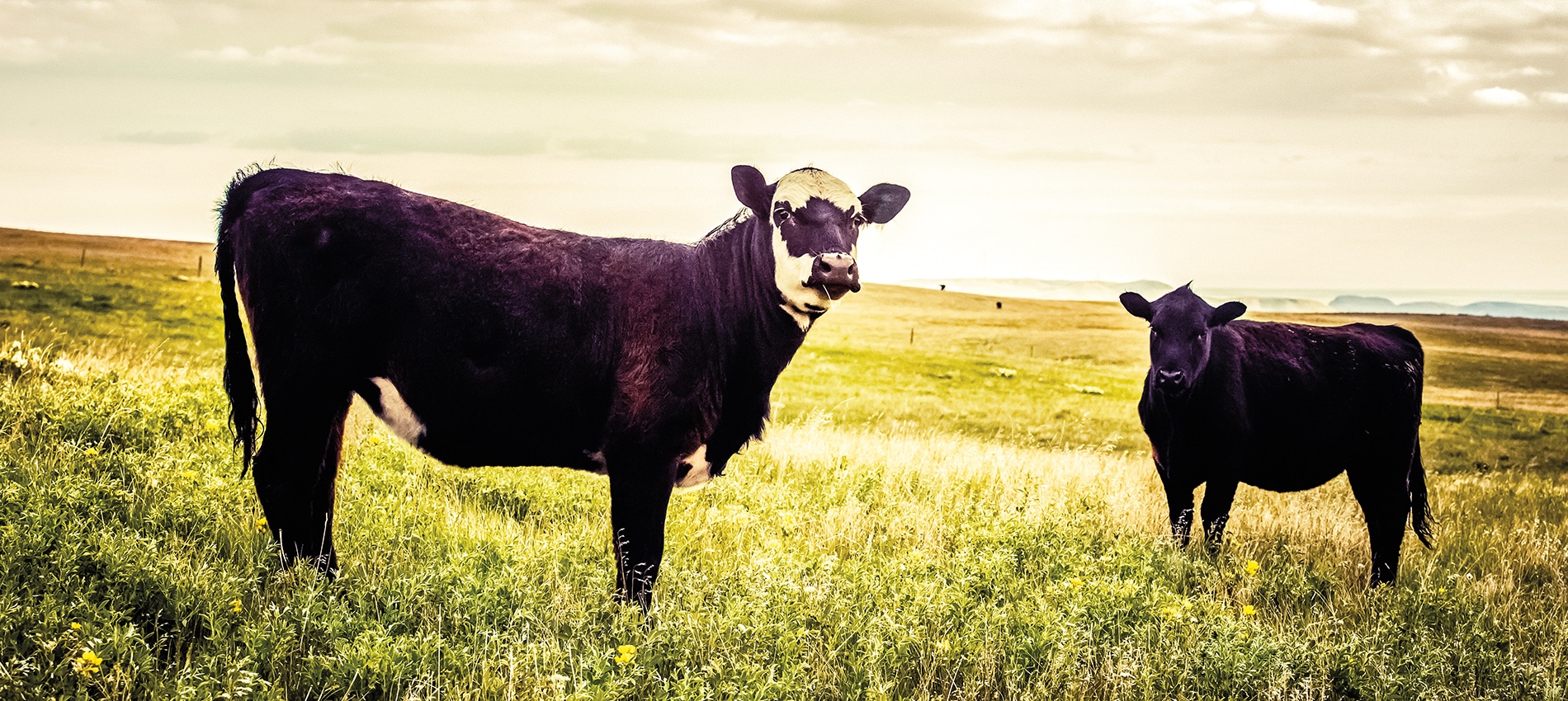
This article is featured in the Winter 2022 issue of LAND magazine. Click here to find out more.
Successful agriculture and effective conservation are interlocking pieces of the same landscape puzzle.
A person can’t successfully ranch or farm without being a conservationist,” said Conni French, who co-owns the C Lazy J Ranch near Malta, Montana, with her husband Craig. “In our experience, they are one and the same—and both are lifelong journeys of learning, applying new knowledge to the land and working with nature instead of fighting it.”
Montana, which is 56 percent rangeland, is home to a strong ranching industry. The synergistic relationship between agriculture and conservation comes into sharp focus in northeastern part of the state where the Frenches operate. The region, home to the nation’s (and one of the world’s) largest intact native prairies, is of high interest because of its rarity, its biodiversity and its role as habitat for grassland birds, whose populations are declining.
Northeast Montana is also part of the Prairie Pothole ecological region. During the last Ice Age, the glaciers left indentions in the landscape that hold pockets of water in the expanse of mid-grass prairie. This creates prime breeding habitat for ducks. In fact, Montana is the third largest duck producing state in America behind North and South Dakota.
According to Bob Sanders, Manager of Montana Conservation Programs for Ducks Unlimited, his organization’s primary goal is putting habitat on the ground. In order to do that, his main job is “ensuring that ranchers stay on the landscape by providing whatever tools they need specific to their piece of ground.” Tools range from cost-share programs for conservation and infrastructure improvement to voluntary conservation easements.
“What do ranchers need? Grass and water. What do duck, grouse, grassland bird and deer enthusiasts need? Grass and water,” Sanders said. “There’s 100 percent overlap between all of these interests and what we do.”
He continued, “When people are in ranching for generations and generations, they know what’s good for land and are committed to doing what’s right, so they are ideal conservation partners.”

Many of the agricultural families in the region trace their roots back to the Homestead Act of 1862 and its subsequent iterations. The original Homestead Act, designed to attract hardy settlers to the untamed wilderness that was identified as a territory in 1864 and didn’t become a state until 1889, offered 160 acres of public land to US citizens on the condition they live on, cultivate and improve it. They could then “prove up” and obtain a deed after five years. Over the last 160 years, the pioneering families have added to their holdings in order to remain viable.
“If these multi-generational agriculturalists didn’t understand sustainability or ignored the health of their soil, their water or their vegetation, they wouldn’t be in business,” said Carly Bishop with United Country Northwest Realty & Auction in Malta, Montana. “Well-managed land and natural resources are essential for their survival in an industry where only the strong survive.”
Survival isn’t a given in the harsh extremes of northeastern Montana. In the summer, temperatures routinely soar past 100°F and in the winter can plummet to -30°F. The climate is semi-arid. In a good year, 10 to 15 inches of rain falls. Currently, the region is in its third year of drought.
The Frenches attribute their longevity in the ranching business to a mantra that earlier generations of their family embraced: When in doubt, do what is best for the land.
“Ranching isn’t a short-run business,” said Craig French. “You have to give back to the land so it will be productive now—and long into the future. In other words, take care of the land and it will take care of you.”
At the C Lazy J, the Frenches, graduates of the Ranching for Profit school, have embraced a rotational grazing system that mimics the nomadic grazing patterns of bison and other large mammals. The prairies evolved under intermittent grazing pressure. The wild herds moved into areas, grazed them hard for a brief period and then left. The plants would rest and regrow before the herds returned.
Today, the Frenches create small enclosures using temporary electric fences to crowd their animals onto a small area to maximize the impact of their grazing which reinvigorates plants, their waste which fertilizes the soil organically, and their hoof impact that opens the soil surface allowing rain to penetrate. The couple monitors the vegetation closely and moves the livestock to a new area once the animals have consumed the top one-third to one-half of the plants.
They have been using the system for the past five years. The changes they have seen in the landscape, including increasing plant diversity and vigor as well as responses in livestock performance and wildlife robustness, have just inspired them to learn more and do more. The next frontier is soil health and balancing the ratio of soil bacteria and fungi to create the optimum foundation for plant growth.
“We have no idea what this land can do if we get out of the way and try to aid it instead of control it,” Conni said. “God designed it perfectly and if we will get over ourselves, observe what is going on and enhance the processes, the sky is the limit.”
She continued, “Throughout time, agricultural families have shared the goal of leaving land better than they found it. The philosophy hasn’t changed, but our knowledge has.”
Craig added, “Out here on our land, we’re writing a never-ending book because our job will never be completed. It’s a constant learning experience, where we have successes and failures, but as we move forward, we’re going to have an army of billions of soil bugs working for us—I can’t wait to see what this land will do.”
The Frenches don’t approach their management responsibilities in isolation, but instead ally themselves with a host of organizations ranging from the Ranchers Stewardship Alliance and USDA’s Natural Resources Conservation Service to Ducks Unlimited, The Nature Conservancy and the World Wildlife Fund.
“In every group, we’ve found good people who have a strong love and passion for what they do, but some may not have the good fortune to own and manage property like we do,” Conni said. “Sometimes, we have to lay our pride and independence aside and ask for help. The resulting relationships are rewarding.”
While the Frenches gather information and inspiration from a variety of sources, the buck ultimately stops with them.
“As we’re trying to figure out what direction to go on our place, we’ll talk to a whole lot of people,” Craig said. “We’re not trying to decide who’s right, but what’s right for our land—and we filter through all of the information to figure out what will work best for us.”
According to Tanner Anderson, who is with United Country Northwest Realty & Auction in Malta, Montana and a fourth-generation Montana rancher, differences in perspective can help improve the conservation outcome.
“Ranchers have a hands-on perspective gained from years of observing and doing, while conservationists have access to new information, ideas and techniques,” Anderson said. “When everyone learns from one another and works together, conservation moves forward.”
He continued, “With that said, landowners are essential to large scale conservation because they control the land, they put the practices on the ground, and they make a difference for land, plants and wildlife—today and in the future.”
